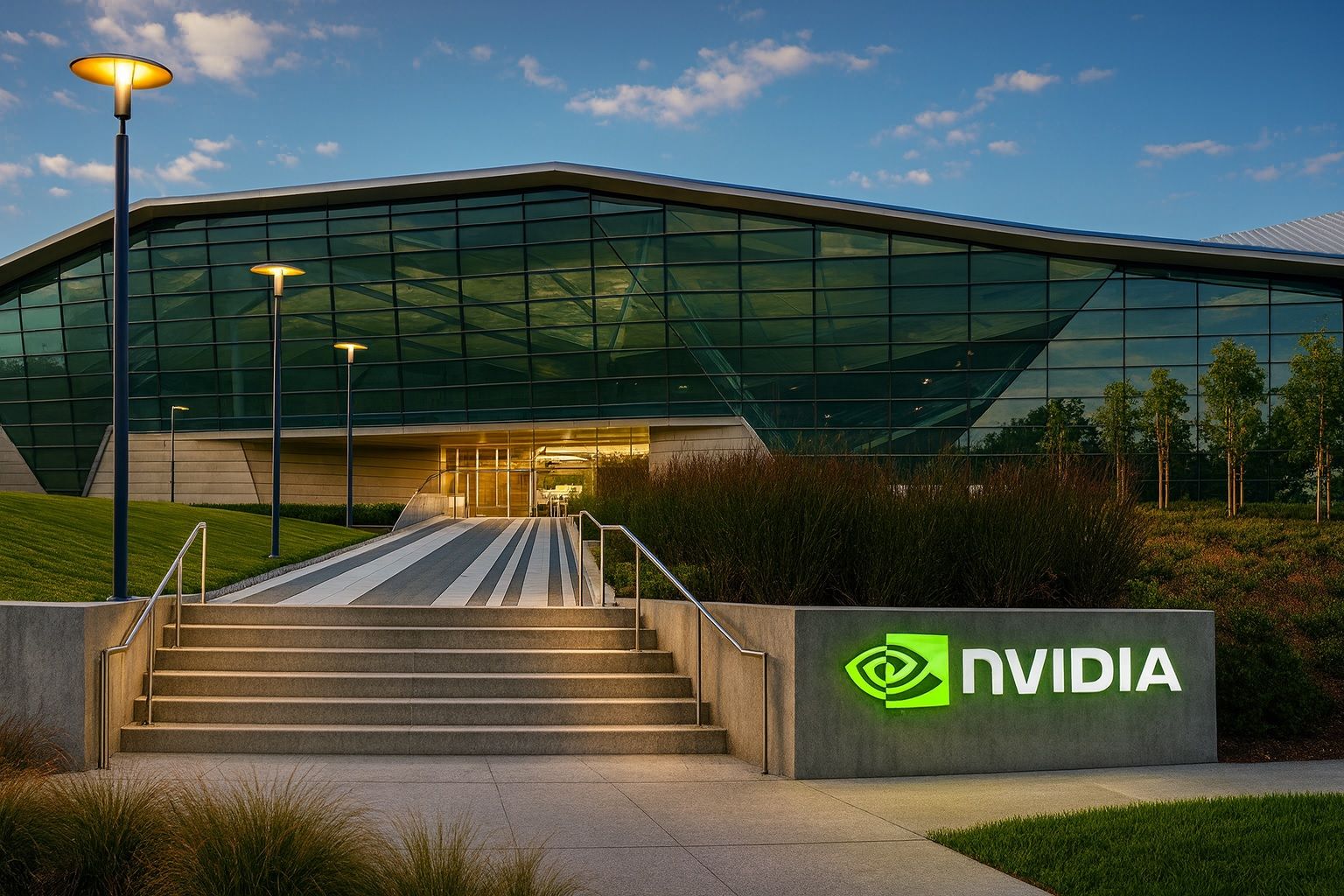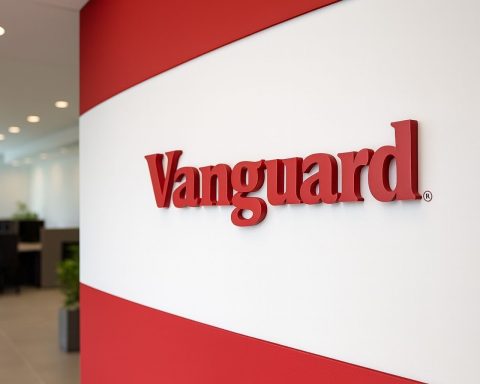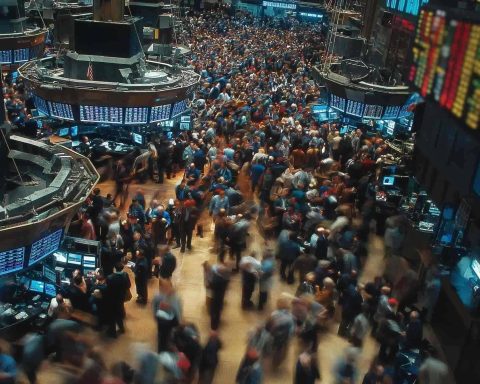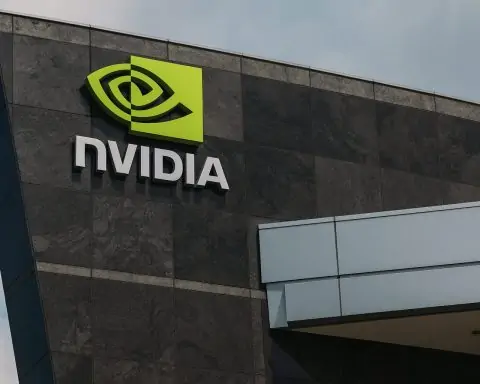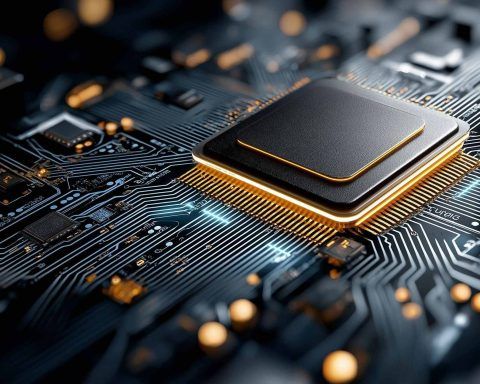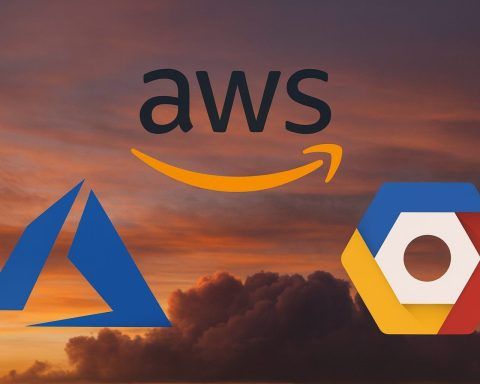- Massive AI chip orders: OpenAI has inked unprecedented deals with Nvidia and AMD in late 2025 to secure 16 gigawatts of cutting-edge AI computing power (10 GW from Nvidia, 6 GW from AMD) over the coming years [1] [2]. These partnerships are fueling a $1 trillion AI infrastructure boom – though some observers note the arrangements are “circular” as the companies invest in each other and loop sales back into funding [3] [4].
- Nvidia’s $100B pledge: In September, Nvidia agreed to invest up to $100 billion in OpenAI and help build out its data centers, with OpenAI committing to fill those facilities with millions of Nvidia’s next-gen GPUs [5] [6]. This direct partnership – Nvidia’s first ever directly with OpenAI – marks a shift from previous deals via cloud providers, giving OpenAI more control over its hardware supply [7]. The first 1 GW of Nvidia’s new “Vera Rubin” chips is slated to come online in late 2026 [8].
- AMD’s 6 GW deal + 10% stake option: On Oct 6, OpenAI named AMD a “core strategic compute partner” and will deploy 6 GW of AMD Instinct GPUs (starting with 1 GW of MI450 chips in 2026) under a multi-year deal [9] [10]. In a unique twist, AMD granted OpenAI warrants to buy up to ~10% of AMD (160 million shares) at just $0.01 each, vesting in tranches as OpenAI installs the GPUs and if AMD’s stock hits lofty targets (up to $600/share) [11]. This “equity sweetener” aligns OpenAI’s incentives with AMD’s success – effectively a rebate on chip purchases if AMD’s business soars [12] [13].
- Market reactions: Investors cheered the AMD alliance as a game-changer. AMD’s stock exploded 30%+ in a day – its biggest jump in 9 years – adding about $80 billion in value [14]. Shares hit roughly $210–220 (up from ~$160s), boosting AMD’s market cap to ~$420 billion [15]. By contrast, Nvidia – now a $4.5 trillion behemoth – dipped ~2% on fears of a new challenger [16] [17]. (Nvidia’s stock hovered near $185 per share as of Oct 8, after a huge 2025 run-up [18].) Analysts called OpenAI’s move a “major vote of confidence” in AMD’s AI chips [19], though they note Nvidia still “sells every AI chip it can make” and retains a dominant market share [20] [21].
- AI “mega-blob” of alliances: These deals are part of a tangled web of mega-investments among tech giants in the AI race. OpenAI’s compute expansion is backed not only by Nvidia and AMD, but also by Oracle (a staggering $300 billion cloud hosting pact for OpenAI’s data centers) and heavy investments from Microsoft (>$13 billion), SoftBank, and even the UAE [22]. Together, OpenAI’s various deals on paper exceed $1 trillion in value, prompting some critics to warn of a “shell game” of circular funding that could be masking risks [23] [24]. OpenAI CEO Sam Altman has admitted the biggest constraint on AI’s growth is access to computing power [25] – hence the frantic push to secure silicon through multi-supplier strategies (even co-developing custom chips with Broadcom and inking memory supply deals with Samsung and SK Hynix) [26] [27].
- High stakes and risks: The optimism comes with enormous challenges. The Nvidia and AMD agreements commit OpenAI to colossal future purchases – on the order of $800 billion in hardware by 2030 if all 16 GW are built out (estimating ~$50 billion per GW) [28]. How a startup valued around $500 billion with ~$4 billion revenue (H1 2025) can fund this is unclear [29]; OpenAI may need tens of billions in new financing [30]. AMD is betting big – if OpenAI achieves its milestones, AMD’s shareholders face ~10% dilution from the warrant [31], essentially “betting the house” on OpenAI’s success. There are execution risks too: AMD must deliver bleeding-edge chips on schedule while Nvidia races ahead with its own next-gen GPUs [32]. Supply bottlenecks (e.g. limited advanced HBM memory) and U.S. export curbs on China could impede production [33]. The sheer energy footprint of OpenAI’s planned 6 GW cluster – about the output of six nuclear reactors (~5 million homes’ usage) – may invite environmental and regulatory scrutiny [34] [35].
- Outlook – boom or bubble?: The frenzy for AI compute has lifted the entire sector – from server makers to chip fabs to memory suppliers – on hopes of years of growth [36]. “This gives [AMD] a major platform to monetize the AI revolution,” noted analysts at Wedbush, erasing doubts about AMD’s AI roadmap [37] [38]. Meanwhile, Nvidia’s CEO Jensen Huang framed his OpenAI partnership as “incremental” to other projects and a validation of Nvidia’s central role in AI infrastructure [39]. Experts, however, urge caution. Some analysts warn these interlocked deals simply recycle capital and could inflate earnings artificially [40] [41]. Reuters commentators dubbed it a potential “profit problem” – a high-stakes bet that assumes AI demand will skyrocket continuously [42]. If the AI boom falters or costs spiral, today’s sky-high valuations could face a sharp correction [43]. For now, though, the industry is forging ahead, betting that unprecedented investment in AI compute will unlock the next era of technological breakthroughs.
OpenAI Fuels a $1 Trillion AI Hardware Boom
OpenAI – the creator of ChatGPT – has positioned itself at the center of an AI hardware buying frenzy that is reshaping the tech industry. In the past few weeks (early October 2025), OpenAI announced two blockbuster chip-supply deals that together span 16 gigawatts of computing capacity – an almost inconceivable scale. (For perspective, 16 GW of data center power is roughly equivalent to the output of 16 large power plants.) These deals, one with long-time AI chip leader Nvidia and the other with rival AMD, are helping propel what analysts dub a “trillion-dollar AI boom” [44] [45].
At their core, the arrangements ensure OpenAI will have priority access to the critical silicon needed to train and run ever-more complex AI models. Sam Altman, OpenAI’s CEO, has repeatedly stressed that compute capacity is the biggest bottleneck in advancing AI – more so than data or algorithms [46]. To remove that bottleneck, OpenAI is effectively cornering the market for high-end AI chips through massive forward contracts and partnerships. In doing so, the company is also accelerating an investment cycle in AI infrastructure of unprecedented magnitude, with tech giants and investors pouring money into what they hope will be the foundation of the next computing revolution.
However, these very deals are also raising eyebrows. Industry watchers note an unusual “circular” nature: OpenAI’s partners are simultaneously its suppliers, investors, and customers in a complex web. For example, Nvidia’s agreement involves it investing huge sums into OpenAI – which then immediately spends that capital on Nvidia’s own chips [47]. Likewise, AMD’s deal grants OpenAI an equity stake that rewards OpenAI if AMD’s stock skyrockets due to OpenAI’s orders [48] [49]. Such intertwined relationships have prompted some critics to compare the situation to a financial “shell game,” where money is shuffling in circles to prop up an entire ecosystem [50] [51]. The big question: Are these mutual mega-deals a virtuous cycle that will truly advance AI – or a high-risk loop that could unravel if any link falters?
Nvidia’s $100 B Commitment – A Direct Pact with OpenAI
The first salvo came from Nvidia, the semiconductor titan whose graphics processing units (GPUs) are the workhorses of AI. In late September 2025, Nvidia and OpenAI unveiled what Nvidia CEO Jensen Huang called their “first direct commercial partnership” [52]. Despite OpenAI’s reliance on Nvidia chips for years, this was the first time the two companies struck a deal without a middleman cloud provider. Huang noted that previously OpenAI mainly acquired Nvidia hardware through Microsoft’s Azure cloud; now OpenAI will buy directly from Nvidia and even have Nvidia help build out OpenAI’s own AI supercomputing centers [53].
Under the agreement, Nvidia is prepared to spend up to $100 billion to finance and equip OpenAI’s data center expansion [54]. In practice, Nvidia’s investment is not a blank check but tied to providing at least 10 GW of its cutting-edge GPU systems to OpenAI [55]. The arrangement essentially sees Nvidia acting as both an investor and a contractor: funding OpenAI’s growth with one hand, while supplying the critical hardware with the other. OpenAI, for its part, committed to purchase and deploy millions of Nvidia’s GPUs across several years, enough to fill multiple AI mega-clusters [56].
The scale of this deal is extraordinary. 10 gigawatts of Nvidia hardware is roughly the compute needed to “power a major city,” Bloomberg noted [57]. In fact, OpenAI’s planned GPU capacity just from Nvidia could rival the entire existing cloud computing power of some large tech firms. The first installment – 1 GW of Nvidia’s next-generation “Vera Rubin” GPU systems – is slated to come online by late 2026 as a proof-of-concept [58]. If all goes to plan, subsequent waves of Nvidia hardware will roll out over later years, giving OpenAI a steady pipeline of the most advanced AI chips on the market.
For Nvidia, this partnership helps lock in a major customer for years and showcases its continued leadership. Despite rising competition, Nvidia currently sells virtually every AI-capable chip it can produce, and demand still far outstrips supply [59] [60]. By directly engaging with OpenAI, Nvidia further cements itself at the core of the AI revolution. “We want to spend up to $100 billion on data centers that use our technologies, which would give about 10 GW of capacity,” Huang explained in an interview, framing it as a win-win that “strengthen[s] Nvidia’s position as the core hardware provider” for large-scale AI [61].
Importantly, Huang characterized the OpenAI deal as “incremental” – meaning it doesn’t replace Nvidia’s other partnerships but adds on top of them [62]. Nvidia is concurrently working with cloud providers like Oracle, specialized AI cloud startups like CoreWeave, and even traditional rivals like Intel on various AI infrastructure projects [63]. The OpenAI project is another giant leg of Nvidia’s grand strategy to dominate AI computing. Wall Street, for the most part, appears to endorse this strategy: even after massive stock gains, 46 out of 46 analysts tracked by MarketBeat in October had Nvidia rated a Buy or Hold (41 Buys), with price targets still ~10–20% above current levels [64]. Nvidia’s market capitalization has ballooned above $4.5 trillion – exceeding even some Big Tech peers – as investors bet on its central role in the AI era [65].
That said, Nvidia’s deal did raise some concerns among financial analysts. Pumping $100 billion into a customer (OpenAI) only to have that money return as chip purchases led to warnings about a “profitability loop.” Essentially, skeptics worry Nvidia might be funding its own sales, which could inflate revenue but squeeze margins if not carefully managed [66]. One Reuters analysis cautioned that these kinds of arrangements can muddy the waters of true demand, calling it a potential “profit problem” if Nvidia is recycling cash to fuel growth [67]. Nvidia dismisses such fears, arguing the investment will spur even greater adoption of its hardware. But it’s a balancing act: the company must ensure its generous support of OpenAI ultimately yields real, independent profit growth, not just artificial sales figures.
AMD’s 6 GW Coup – A “Transformative” Alliance
Hot on the heels of Nvidia’s announcement, AMD (Advanced Micro Devices) stunned the market in early October with its own partnership with OpenAI – one perhaps even more surprising. AMD has long been seen as a distant second to Nvidia in the AI accelerator arena. But OpenAI’s deal instantly vaults AMD into the big leagues of AI hardware. As AMD’s Executive VP Forrest Norrod put it, “We view this deal as certainly transformative, not just for AMD, but for the dynamics of the industry” [68].
The agreement will see OpenAI purchase up to 6 GW of AMD’s Instinct data center GPUs across multiple future generations [69]. It starts with 1 GW of AMD’s forthcoming MI450 accelerators (expected in late 2026), then extends through later models (MI460s, MI500s and beyond) as they are developed [70] [71]. In total, hundreds of thousands of high-end chips will be supplied – representing a huge chunk of AMD’s production pipeline for years. For OpenAI, this diversifies its silicon sources, ensuring that it’s not entirely dependent on Nvidia for AI computing. “AMD will be a core strategic compute partner for us,” Sam Altman said, calling the alliance “a major step in building the compute capacity needed to realize AI’s full potential” [72].
What truly grabbed attention was the equity kicker embedded in the deal. AMD granted OpenAI a warrant (essentially an option) to buy up to ~10% of AMD’s shares at a token price of one penny per share [73]. At the time of signing, 160 million shares was roughly a tenth of AMD, worth about $34 billion at market prices – an eye-popping stake for OpenAI. Of course, OpenAI can’t exercise it all immediately; the warrant vests in pieces only if certain milestones are met. The first chunk vests once OpenAI successfully deploys the initial 1 GW of AMD GPUs in its data center [74]. Further tranches require hitting cumulative capacity targets (all the way up to the full 6 GW) and, notably, AMD’s stock price must rise to pre-set levels – culminating in a final target of $600 per share for the last tranche [75]. For context, AMD was trading around $150 before the deal, so $600 represents a nearly 4× increase. In other words, OpenAI only gets to grab that 10% ownership if AMD’s AI business truly explodes (taking its stock to stratospheric heights).
This structure was intended to “align incentives” for the partnership, says AMD. OpenAI gains enormously only if AMD’s hardware performs superbly and sells in huge numbers (much of it to OpenAI itself) – which would mean OpenAI’s projects succeed too. AMD’s CFO Jean Hu noted that OpenAI “only gains that stake if the deployments succeed and AMD’s stock soars,” effectively rewarding both sides together [76]. She touted the partnership as “highly accretive” to AMD’s earnings and a source of “massive shareholder value” if all goes well [77]. In essence, AMD traded the possibility of giving OpenAI a slice of ownership in the future, in return for guaranteed multi-year revenue starting now.
From AMD’s perspective, the deal is a huge validation of its technology and a rare chance to dent Nvidia’s dominance. “It showcases AMD as a credible alternative to Nvidia” in AI, said Norrod [78]. Just a year ago, many doubted if AMD’s AI chips could compete; Nvidia’s GPUs like the A100 and H100 were considered the gold standard for training large AI models. But AMD has been improving rapidly, and OpenAI’s stamp of approval put any remaining skeptics on notice. “This gives [AMD] a major platform to monetize the AI revolution,” observed analysts at Wedbush Securities, adding that it likely erases any lingering doubts about AMD’s AI roadmap [79]. Another analyst noted that AMD “has really trailed Nvidia for quite some time. So I think this helps validate their technology” in AI accelerators [80].
The stock market’s reaction was instantaneous and dramatic. On Oct 6, when news of the OpenAI-AMD alliance broke, AMD’s stock surged over 30% in one day, the kind of leap more common in penny stocks than a $300+ billion company [81]. It was AMD’s largest single-day percentage gain since 2016, catapulting the stock above ~$210 per share (from the mid-$160s) in frenzied trading [82]. By day’s end, AMD’s market capitalization had swelled by roughly $80 billion [83]. For context, that’s like adding the value of a Fortune 100 company in hours. The rally reflected investors’ view that AMD’s future in AI is now much brighter – it secured a marquee customer (OpenAI) and a multi-year revenue stream potentially worth tens of billions annually [84]. Indeed, AMD executives said the OpenAI deal could generate more than $100 billion over about four years when including follow-on business from other clients who “follow OpenAI’s lead” [85] [86]. Considering AMD’s total revenue in 2025 was only ~$33 billion, this deal “could be truly transformative,” as one industry veteran remarked.
By contrast, Nvidia’s stock dipped slightly (around 1–2%) on the AMD news [87]. While a few percentage points is minor for a volatile stock like Nvidia, the symbolism was noteworthy – it was one of the rare sessions in 2025 where Nvidia fell while an AI peer rose sharply. The market was essentially acknowledging that AMD is now a real competitor in high-end AI chips, whereas before Nvidia had an almost monopolistic grip (estimated ~90% market share in AI accelerators) [88]. Still, most analysts cautioned that Nvidia’s lead remains significant; “it’s unlikely to dent Nvidia’s dominance” in the near term, since Nvidia continues to have more advanced software ecosystems and is supply-constrained selling every chip it can make [89] [90]. In fact, even as AMD’s news grabbed headlines, Nvidia’s own fundamentals haven’t faltered – its latest quarter saw data center revenue soar 56% year-on-year to $41 billion [91]. Both AI chip makers appear poised to ride the overall wave of demand, at least for now.
The Web of “Circular” Deals: AI’s Mega-Blob of Partnerships
Beyond Nvidia and AMD, OpenAI’s aggressive expansion has entangled a who’s who of tech firms and investors in a sprawling network of alliances – what some have dubbed an AI “mega-blob” of deals [92]. In 2023–2025, money and contracts have been flowing on an unprecedented scale to support OpenAI’s ambitions:
- Microsoft kicked it off by investing early and often – over $13 billion to date – into OpenAI, and integrating OpenAI’s tech into products like Bing and Office [93]. Microsoft’s Azure became OpenAI’s default cloud, until these new partnerships hinted at OpenAI operating more of its own infrastructure.
- Oracle made waves with a $300 billion commitment to provide cloud capacity for OpenAI [94]. This gargantuan deal (spread over ~5 years) essentially turns Oracle’s cloud division into a key host for OpenAI’s future supercomputers. Oracle, a legacy database company, has struggled to gain ground in cloud computing; hitching itself to OpenAI’s skyrocketing needs could instantly make it a top-tier AI cloud player.
- Broadcom was tapped by OpenAI to co-develop custom AI chips (ASICs) tailor-made for OpenAI’s workloads [95]. This is a longer-term hedge – if GPU shortages or costs become prohibitive, OpenAI might have its own proprietary silicon designs ready. It’s also a sign that OpenAI doesn’t want to be beholden to any single supplier (even Nvidia) for the long run.
- Cloud & data center partners: OpenAI has reached beyond the U.S. as well. It struck deals with Samsung Electronics and SK Hynix to secure supplies of advanced memory (HBM3) and to potentially build data centers in South Korea [96]. High-bandwidth memory chips are essential for AI GPUs, and in 2025 there were global shortages of HBM due to surging AI demand. By partnering with memory makers, OpenAI aims to guarantee supply for itself (and those partnerships sent Samsung and SK Hynix stocks up 4–12% as investors anticipated huge orders) [97]. We’re even seeing national governments get involved – e.g., the UAE’s sovereign funds reportedly invested billions into OpenAI, and other countries are courting OpenAI to site some of its “Stargate” supercomputers in their region [98].
This tangle of deals has one overarching goal: ensure OpenAI can scale up compute power at breakneck speed to support more advanced AI models (like future GPT iterations or new AI applications such as the “Sora” AI video generator OpenAI is working on). By early 2025, OpenAI formally announced “Project Stargate,” a plan to spend up to $500 billion building out global AI supercomputers over the rest of the decade [99]. That staggering figure underscores why OpenAI is effectively pre-buying as much silicon and cloud infrastructure as it can – it has committed itself to an AI arms race where only those with enough computing muscle can compete at the cutting edge.
However, the sheer scale and interconnectedness of these commitments have drawn skepticism. Axios and Bloomberg reports noted that many of these deals involve parties investing in one another or relying on optimistic future revenues – a potential house of cards if the AI boom doesn’t live up to expectations [100] [101]. For instance, Nvidia’s $100B investment in OpenAI only makes sense if Nvidia can recoup that via chip sales to OpenAI (and perhaps equity appreciation in OpenAI). Oracle’s $300B cloud deal likely assumes OpenAI’s usage will be immense – but if OpenAI falls short or switches some workloads to its own data centers, that revenue might never fully materialize. There are also questions of whether these headline figures (hundreds of billions) are more notional than actual – often they are spread over many years and contingent on performance targets.
Financial commentators have started asking: is there an AI bubble? When relatively young companies like OpenAI command half-trillion-dollar valuations and engage in multi-billion deals with one another, comparisons to the dot-com bubble of the late 90s naturally arise. “Investors, at least, already trust in the fantasy,” one Reuters Breakingviews columnist remarked after AMD’s stock popped on the OpenAI news [102]. The “fantasy” being that all players involved will somehow achieve the growth implied by these deals. Another red flag: OpenAI’s own finances show it burning cash at a ferocious rate (over $2.5 billion in just the first half of 2025) and not expecting to turn a profit until possibly 2029 [103]. If the funding environment tightens or AI adoption slows, some dominoes in this interdependent setup could fall.
In the meantime, though, each new alliance seems to further legitimize AI’s importance and spur even more investment. The phrase “AI arms race” is apt – no one wants to be left behind. As OpenAI buys chips by the gigawatt, other AI labs and tech giants feel pressure to secure their own supply. We’ve seen cloud providers like Google and Amazon ramp up spending on in-house AI chips (TPUs and Trainium chips, respectively) to avoid reliance on Nvidia. And we’ve seen Meta (Facebook) pour resources into AI research and even consider building custom silicon. OpenAI’s aggressive moves effectively force others to ante up, lest they risk losing an edge in the next wave of AI advancement. This competitive dynamic may keep the cycle going, as long as real progress in AI capabilities continues to justify the investments.
Market Impact: Winners, Losers, and Ripple Effects
The immediate financial impact of OpenAI’s mega-deals has been starkly visible in stock markets. AMD’s stockholders were the biggest winners overnight. AMD’s ~30% surge on Oct 6 added roughly $80 billion to the company’s market cap [104] – a clear sign that investors believe AMD’s future revenues (and profits) will be much higher thanks to OpenAI. The market is essentially pricing in the tens of billions in chip sales that AMD expects from this deal. In fact, AMD’s finance chief noted the partnership could bring in over $100 billion across the next four years when accounting for other business it might attract [105]. AMD’s share price, which had languished behind Nvidia’s for much of the year, suddenly closed the valuation gap somewhat. “Major vote of confidence” is how analysts described it [106] – confidence that AMD’s AI hardware and software (the ROCm platform) can finally compete in the big leagues.
For Nvidia, the reaction was more mixed. A 2% dip in Nvidia’s trillion-dollar stock is not very significant by itself (Nvidia shares are volatile and can swing 2–3% in any given day). But symbolically, it signaled investor recognition that Nvidia’s near-monopoly might not last forever. With OpenAI openly embracing a second supplier, Nvidia will face pricing pressure and must continue to innovate at breakneck speed to stay ahead. After all, OpenAI likely negotiated favorable terms with AMD – potentially cheaper chips or priority supply – which could push Nvidia to offer better pricing or risk ceding more share of OpenAI’s expanding compute needs. In the days after the AMD news, Nvidia’s CEO tried to downplay any rift, even congratulating AMD on the deal. Huang emphasized that Nvidia too has more business than it can handle and that the OpenAI arrangement is “incremental” – suggesting Nvidia isn’t losing existing business but rather participating in a new project alongside others [107]. Indeed, Nvidia’s revenue forecasts remain towering (projected to exceed $200 billion in 2026) [108], and the company is still viewed by many as the indispensable supplier for AI startups and cloud giants. Its stock is up ~58% over the past year [109], an astounding gain for a company of its size.
The ripple effects extended beyond these two companies. Other firms in the AI supply chain saw boosts as the scale of OpenAI’s plans became clear. High-performance memory makers like Samsung and SK Hynix jumped 4–12% to multi-year highs after it was revealed they are supplying advanced HBM3 memory for OpenAI’s projects [110]. This assuaged fears that the memory industry might face oversupply; instead, it appears AI demand will soak up capacity. Likewise, companies that build AI servers and networking gear, such as Super Micro Computer, saw their stock rally on expectations of massive orders. Even foundries like TSMC (which manufactures chips for AMD and others) benefited, since more GPU orders will mean higher chip production volumes [111].
On the flip side, rivals and incumbents that are perceived to be lagging in the AI race have felt pressure. For instance, cloud providers without a clear AI strategy could lose big enterprise customers to those aligned with top AI firms. Traditional CPU-centric companies (e.g. Intel) face even stronger competitive headwinds now that AMD is doubling down on AI accelerators. If AMD successfully leverages the OpenAI partnership, it could translate know-how to improve its other chips (CPUs, adaptive processors, etc.) and gain an edge over Intel in data center contracts. Intel’s stock was relatively flat during this news, but analysts have noted that Intel’s absence from these headline deals (aside from a minor role via its partnership with CoreWeave) underscores its challenges in the AI era.
There’s also the broader macroeconomic angle. With AI being a major growth driver in the stock market, any sign of AI momentum (like OpenAI securing more resources) tends to lift market sentiment, whereas any stumble could spook investors. In fact, the Bank of England recently warned that if investor “mood sours on AI,” it could trigger a sharp market correction, given how much optimism is baked into tech valuations [112]. We’ve already seen enormous wealth creation: the AI boom helped Nvidia briefly join Apple and Microsoft in the exclusive club of companies worth over $1 trillion (in Nvidia’s case, soaring well above that) [113]. Now AMD’s value is surging on AI hopes. But if, say, AI adoption in enterprise proves slower than expected, or political/regulatory roadblocks emerge, these stocks could tumble just as quickly. In other words, the market is high on AI – and highly sensitive to any AI-related news.
Can the AI Frenzy be Sustained? (Forecast & Challenges)
Looking ahead, the big question is: Will these enormous bets on AI infrastructure pay off? In the optimistic scenario shared by many in Silicon Valley, we are in the early innings of a decades-long transformational boom. Under this view, today’s generative AI (like GPT-4) is just the tip of the iceberg – future AI models will be far more powerful, unlocking new applications across every industry from healthcare to finance to education. To enable that future, companies like OpenAI must scale up compute by orders of magnitude, which is exactly what these deals aim to do. If that future materializes, the investments by Nvidia, AMD, Oracle, etc. will look wise and yield huge returns. For instance, if OpenAI (or its partners) achieve breakthrough AI capabilities that drive surging demand for AI services, Nvidia’s $100B investment could turn into hundreds of billions in chip sales, and AMD’s gamble could make it a much larger company (possibly with OpenAI as a major shareholder).
Analysts remain largely bullish that we will indeed see an AI-driven growth spurt. Wall Street’s consensus price targets for Nvidia stock in late 2025 were around $210–$220 [114] [115], implying the market expects continued revenue outperformance. For AMD, many analysts upgraded their forecasts post-deal, seeing the OpenAI win as a catalyst that could finally accelerate AMD’s data center business. The fact that OpenAI chose AMD suggests AMD’s upcoming GPUs (MI300X, MI450, etc.) are technologically promising; if they can even approach Nvidia’s performance for training big models, AMD could grab meaningful market share. Some have likened AMD’s potential now to its historical gains against Intel in CPUs – if it executes well, it could go from underdog to a strong second player in AI, which in a trillion-dollar market, is a very lucrative place to be.
On the flip side, risks abound. One major concern is the financial strain on OpenAI. Even with supportive partners, OpenAI is essentially committing itself to spend unprecedented sums. The rough estimate floated by Reuters Breakingviews was ~$800 billion in capital needed through 2030 to fulfill 16 GW of compute orders (Nvidia + AMD deals) [116]. This is an astronomical number – for comparison, it’s more than the combined annual revenue of the entire global semiconductor industry today. OpenAI doesn’t have that kind of money, so it will require continuous fundraising or revenue growth (or likely both). There’s talk that OpenAI may pursue an IPO or additional equity rounds that could involve major sovereign wealth funds or strategic investors. Debt financing is another possibility (AI data centers could be financed like infrastructure projects). But raising capital at the scale of hundreds of billions could prove challenging, especially if economic conditions tighten or if investors grow concerned about OpenAI’s cash burn. In H1 2025 alone, OpenAI spent $2.5B more cash than it took in [117]. That burn rate will only increase as it starts building these giant compute facilities. Bottom line: OpenAI will need deep pockets behind it to avoid running out of money before the AI payoff arrives.
Another risk is technological timing. OpenAI’s deals assume that Nvidia and AMD will deliver their future chips on schedule and that those chips will be competitive. Nvidia has an ambitious roadmap (the “Vera Rubin” generation in 2026, etc.), and it has executed well historically. AMD, however, still has to prove that its next-gen MI300X/MI400/MI450 can meet OpenAI’s needs for training the largest models. If AMD’s silicon lags significantly behind Nvidia’s in real-world performance, OpenAI might end up using far fewer AMD GPUs than planned (or repurposing them mostly for less demanding tasks like inference). That could jeopardize the full realization of the 6 GW deal. It’s notable that even as AMD touts this deal, observers say Nvidia’s GPUs remain the “gold standard” for cutting-edge AI model training [118]. AMD’s are gaining ground, but primarily excel in inference (running trained models) rather than training, which is the most compute-intensive and lucrative segment [119]. So a key question is whether AMD can make the leap in the next chip generation to truly compete for training workloads. If not, OpenAI might still end up buying the lion’s share of its chips from Nvidia (or even developing its own chips with Broadcom faster than anticipated).
There are also operational hurdles. Building out data centers at the scale of gigawatts is not trivial. OpenAI will effectively be constructing some of the world’s largest computing facilities. This involves securing physical sites, power sources (6 GW is about six nuclear reactors worth of electricity consumption [120]), cooling infrastructure, and navigating any local environmental regulations. Such projects often face delays – whether due to permitting, engineering challenges, or supply chain delays (like getting enough power converters, cooling equipment, etc.). We’ve already seen supply constraints in critical components like HBM memory and advanced chip packaging; a ramp to so many GPUs could strain these supply chains further [121]. Any significant delay or cost overrun in building the data centers could slow OpenAI’s AI development timeline, potentially allowing competitors to catch up or causing investor sentiment to waver.
Another factor to watch is regulation and geopolitics. AI has captured regulators’ attention, and so have the chips that power AI. The U.S. government has been tightening export controls on high-end AI chips to countries like China, which could indirectly affect Nvidia and AMD’s global market (though not directly OpenAI, which is U.S.-based). But more directly, if AI systems become more powerful, there could be regulatory limits on deploying them widely without oversight, which might temper the breakneck deployment OpenAI is planning. Additionally, antitrust concerns could emerge: if Nvidia’s investments and partnerships start to look like it’s gaining undue control over the AI supply chain, regulators might scrutinize those deals (especially Nvidia investing in a top AI customer like OpenAI while also supplying others) [122]. For now, that seems a distant risk, as the focus is on innovation, but as the dollars and impacts grow, so will regulatory interest.
In summary, the forecast for this AI chip boom is immense promise entwined with high risk. In the near term, it’s clear that AI demand is surging – OpenAI’s urgency to secure chips is testament to the exponential growth in model sizes and usage. This suggests that companies like Nvidia, AMD, and their suppliers are likely to report very strong growth in the coming quarters, as long as they can deliver product. The stock market has already been rewarding those poised to benefit (witness the rallies in AI-exposed stocks). Longer term, much will depend on whether AI can deliver revolutionary products that justify the investment. The “AI revolution” is often compared to the Internet revolution or the mobile revolution – transformative once-in-a-generation shifts. If it truly is that big, then today’s massive spending will look prescient. If not – if, say, AI hits technical plateaus or society pulls back on certain applications – there could be an investment overhang.
One thing is certain: all eyes will be on OpenAI, Nvidia, and AMD in the coming months and years to see how this grand experiment plays out. As one tech strategist quipped, “It’s as if the entire industry decided to bet the farm on AI – now they have to make sure the crop comes in.” So far, each new milestone (a breakthrough model, a robust enterprise adoption, etc.) has only increased conviction. The partnerships described above have laid an epic foundation for AI’s future – a vast network of money, silicon, and talent working in concert. If they succeed, they won’t just boost a few companies’ fortunes; they could accelerate technological progress in a way that genuinely changes the world. If they stumble, the unwinding of these circular bets could be painful. For now, the mantra in the sector is full speed ahead, as the AI gold rush of 2025 shows no signs of slowing down [123] [124].
Sources: Bloomberg [125], Reuters [126] [127] [128], CNBC/Reuters (interview) [129], ts2.tech (Tech Space 2.0) [130] [131], Reuters Breakingviews [132], The Guardian [133], Investopedia [134], company press releases and filings [135] [136].
References
1. www.reuters.com, 2. www.reuters.com, 3. news.bloomberglaw.com, 4. ts2.tech, 5. news.bloomberglaw.com, 6. www.reuters.com, 7. www.gurufocus.com, 8. www.reuters.com, 9. www.reuters.com, 10. ts2.tech, 11. www.reuters.com, 12. www.reuters.com, 13. ts2.tech, 14. www.reuters.com, 15. ts2.tech, 16. ts2.tech, 17. ts2.tech, 18. ts2.tech, 19. www.reuters.com, 20. www.reuters.com, 21. www.reuters.com, 22. ts2.tech, 23. ts2.tech, 24. ts2.tech, 25. ts2.tech, 26. ts2.tech, 27. ts2.tech, 28. www.reuters.com, 29. www.reuters.com, 30. ts2.tech, 31. ts2.tech, 32. ts2.tech, 33. ts2.tech, 34. www.reuters.com, 35. ts2.tech, 36. ts2.tech, 37. ts2.tech, 38. ts2.tech, 39. www.gurufocus.com, 40. ts2.tech, 41. ts2.tech, 42. ts2.tech, 43. ts2.tech, 44. news.bloomberglaw.com, 45. ts2.tech, 46. ts2.tech, 47. news.bloomberglaw.com, 48. www.reuters.com, 49. www.reuters.com, 50. ts2.tech, 51. ts2.tech, 52. www.gurufocus.com, 53. www.gurufocus.com, 54. news.bloomberglaw.com, 55. news.bloomberglaw.com, 56. news.bloomberglaw.com, 57. news.bloomberglaw.com, 58. www.reuters.com, 59. www.reuters.com, 60. www.reuters.com, 61. www.gurufocus.com, 62. www.gurufocus.com, 63. www.gurufocus.com, 64. ts2.tech, 65. ts2.tech, 66. ts2.tech, 67. ts2.tech, 68. www.reuters.com, 69. ts2.tech, 70. ts2.tech, 71. ts2.tech, 72. ts2.tech, 73. www.reuters.com, 74. www.reuters.com, 75. www.reuters.com, 76. ts2.tech, 77. ts2.tech, 78. ts2.tech, 79. ts2.tech, 80. www.reuters.com, 81. www.reuters.com, 82. ts2.tech, 83. www.reuters.com, 84. www.reuters.com, 85. www.reuters.com, 86. ts2.tech, 87. ts2.tech, 88. ts2.tech, 89. www.reuters.com, 90. www.reuters.com, 91. ts2.tech, 92. ts2.tech, 93. ts2.tech, 94. ts2.tech, 95. ts2.tech, 96. ts2.tech, 97. ts2.tech, 98. ts2.tech, 99. ts2.tech, 100. ts2.tech, 101. news.bloomberglaw.com, 102. www.reuters.com, 103. www.reuters.com, 104. www.reuters.com, 105. www.reuters.com, 106. www.reuters.com, 107. www.gurufocus.com, 108. ts2.tech, 109. ts2.tech, 110. ts2.tech, 111. ts2.tech, 112. ts2.tech, 113. ts2.tech, 114. ts2.tech, 115. www.gurufocus.com, 116. www.reuters.com, 117. www.reuters.com, 118. www.reuters.com, 119. www.reuters.com, 120. ts2.tech, 121. ts2.tech, 122. ts2.tech, 123. ts2.tech, 124. ts2.tech, 125. news.bloomberglaw.com, 126. www.reuters.com, 127. www.reuters.com, 128. www.reuters.com, 129. www.gurufocus.com, 130. ts2.tech, 131. ts2.tech, 132. www.reuters.com, 133. ts2.tech, 134. ts2.tech, 135. ts2.tech, 136. www.reuters.com
